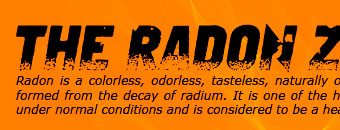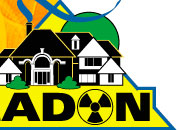 |
 |
 |
||||
|
||||||
| Call: 417-844-0942 | ||||||

20 Years after Radon Abatement Act, Exposure Getting Worse Nearly two decades after passage of the 1988 Indoor Radon Abatement Act (IRAA), exposure to indoor radon continues to grow. Efforts to reduce exposure through mitigation or building with radon-resistant new construction have not kept pace, according to a new report from EPA's Office of Inspector General (OIG). Of 6.7 million new single-family detached homes built nationwide between 2001 and 2005, only about 469,000 incorporated radon-resistant features. Of 76.1 million existing single-family homes in the United States in 2005, only about 2.1 million had radon-reducing features in place. [click here for the complete story]
Can Radon Put You at Risk for Brain Cancer, Alzheimer's Disease, and Parkinson's Disease?
In a study conducted at the University of North Dakota, researchers discovered that the concentrations of radioactive radon daughters in the brains of non-smoking persons with Alzheimer’s and Parkinson’s disease averaged about 10 times greater than in the brains of persons with no previous evidence of neurological disorders. Professor Glenn Lykken and Dr. Berislav Momcilovic assert their study demonstrates that indoor radon gas has the capacity to irreversibly infest the brain with the poisonous progeny of radioactive heavy metals. [click here for the complete story] 
"Radon - A Physician's Guide: The Health Threat With A Simple Solution" U.S. Environmental Protection Agency Office of Air and Radiation (6609J) EPA Document #402-K-93-008 September 1993 This booklet on radon has been developed for physicians by the U.S. Environmental Protection Agency in consultation with the American Medical Association (AMA). Its purpose is to enlist physicians in the national effort to inform the American public about the serious health risk posed by indoor radon gas. Introduction Lung cancer's very high associated mortality rate is even more tragic because a significant portion of lung cancer is preventable. While smoking remains the number one cause of lung cancer, radon presents a significant second risk factor. That is why, in addition to encouraging patients to stop smoking, it is important for physicians to inquire about and encourage patients to test for radon levels in their homes. One way to do this is for physicians to join those health care professionals and organizations who have begun to include questions about the radon level in patients' homes on standardized patient history forms. Because the public views physicians as advisors on health and prevention of disease, physicians are in a unique position to play a vital role in informing the public about the common and serious risk of radon, and in educating their patients in testing procedures and remediation methods for correcting elevated indoor radon levels, thereby helping to reduce the number of lung cancer deaths. Information on free radon materials (publications, pamphlets, videos) are available via EPA's website and you can order them from NSCEP. You can also contact your state radon office to assist you in educating your patients about radon. [click here for the complete story]
Crawl Spaces Many homes built on crawl space foundations in the Southeastern United States suffer from poor moisture management. Some of the common symptoms of a crawl space moisture problem are: » Mold or moisture damage. » Musty odors in the living area. » Condensation ("sweating") on air conditioning ductwork or equipment. » Condensation on insulation, pipes, truss plates. » Buckled hardwood floors. » High humidity in the living area. » Insect infestations. |
Latest News Agreement could place tougher limits on radon
Latest News By MIREYA NAVARRO But the building is hardly a model of energy efficiency. According to an environmental assessment last year, it did not score high enough to qualify for the Energy Star label granted by the Environmental Protection Agency, which ranks buildings after looking at a year’s worth of utility bills. The building’s cooling system, a major gas guzzler, was one culprit. Another was its design: to get its LEED label, it racked up points for things like native landscaping rather than structural energy-saving features, according to a study by the General Services Administration, which owns the building. [click here for the complete story]
Latest News United Nations Group Says Evidence Linking Radon to Lung Cancer Exists
Previous estimates of risk for radon were calculated from health studies of underground miners, who were exposed to high levels of radon and its decay products. Now the Committee has evaluated recent direct studies of the public, in Europe, North America and China, exposed to relatively low levels of radon in their homes. [click here for the complete story]
RADTown USA |
|
||||


















